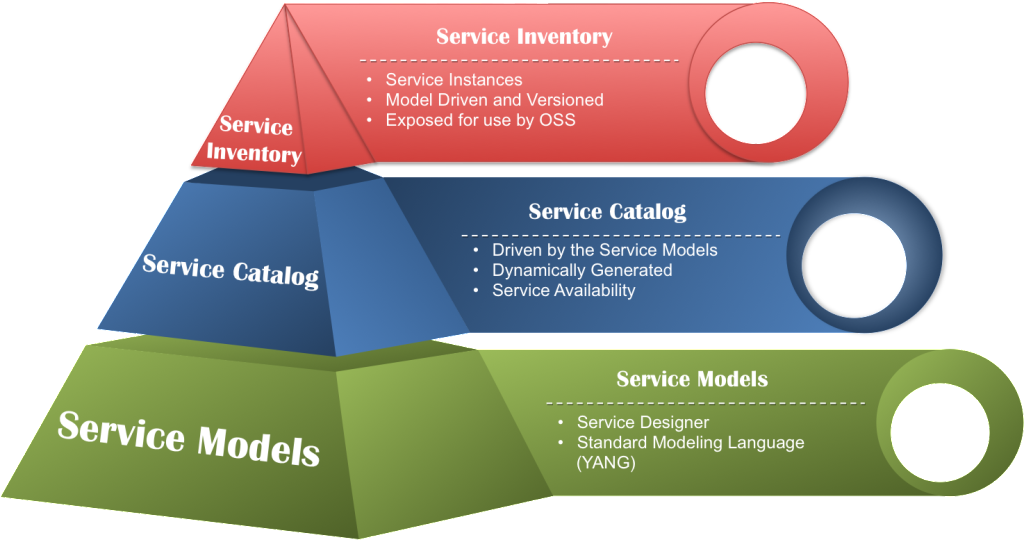As we work with customers we notice many things about this new landscape that is being introduced. Some of these things are very network-centric, most are very operations-centric, and some of the most interesting are OSS-centric…especially in the area of Service Catalogs and Service Inventories. The changes being injected into the network are causing a bottoms-up wave of impacts that move through the management domains, sometimes causing chaos and other times providing a refreshing level of clarity to how things should have been done all along.
Traditional OSS has focused on physical and logical attributes of the network. Things like rack, shelf, slot, port, VLAN, VPI/VCI, etc have driven the story. It isn’t that those things are no longer important, but instead that those legacy views are pretty well covered with current solutions. However, we are now evolving into a services focused world, as opposed to an infrastructure focus.
Everything for the last 10 years or so has been about more speed, more speed, more speed. Service Providers have been pushing their networks to deliver more bandwidth to the customer, but have been delivering largely the same product. This has opened the door for Over The Top (OTT) players to encroach on Service Provider revenues by providing services that no one else was offering.
The modern consumer has begun to accept the speed of their internet connection as a given, with the real meaty services coming from the Google’s, Apple’s, Netflix’s, etc of the world. They don’t care that ABC Cable is their internet provider, only that their movie streams at an acceptable quality or they can download that new song that just came out. As long as this is the case, the Service Provider is invisible to them. This commoditization of the Service Provider has resulted in a situation where the only publicity generated for Service Providers these days seems to be customer service horror stories, outage horror stories, or maybe that fiber has now gotten to where you live and you can stream Netflix movies at even higher quality. This has to change for survival’s sake, if no other, and most Service Providers realize this.
Part of this change is enabled by the introduction of SDN and NFV to the Service Provider network. This allows a Service Provider to not only implement a dynamic, flexible network to improve operations, but also allows the Service Provider to “Over The Top themselves” and provide a lot of the services that the OTT players are delivering to their customers today. The problem is that managing these services is not the same ballgame they have been playing all these years. Those same OSS components that are great at tracking physical assets get out of their depth pretty quickly when you add in dynamic virtual components that change often.
Services are no longer static, but instead change as the customer need changes. They are no longer managed by a phone call from the customer to a call center representative, but instead are changed by the customer themselves via self-service portals. To enable this kind of flexibility and customer control your OSS must manage Services in as dynamic and flexible a manner as possible.
The best way to achieve this is to have a model-based approach to your Service Catalog. This means building Service Models in a standard modeling language such as YANG, and having a repository of these Service Models that drive your Service Provisioning process. A Service Designer can be implemented that provides user friendly definition of the Models, as well as the ability to dynamically generate forms that can be used to manage details such as defaults and available values for Service attributes.
The repository of Service Models is directly translated into a catalog of Service offerings. Additional meta-data built on top of the Service Catalog provides the capability to define Service Availability for each offering. This ensures that for each Service Provisioning activity the chosen Service has the requisite network and geographic requirements met.
The next layer on this Service Management toolset is to then take the repository of all provisioned Services and maintain those items in a Service Inventory. By building this full stack of capabilities from the Model through Inventory, and enforcing the business practice that all Service activity go through this process and toolset, a dynamic Service Management environment is created where:
- Service Models can be modified and the changes flow up through the process immediately
- New Services can be introduced and provisioned very quickly
- Service Assurance systems have access to Services details that are accurate and complete
- Service Availability is accurate and complete for the Ordering process
In today’s ever more dynamic network it is more important than ever to move to this approach. We here at Itential believe that you can’t afford not to make this move, and the sooner you begin the process the better for your business.
Tags: Automation Strategy VLAN

